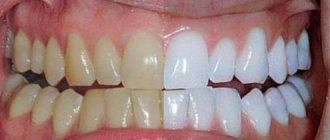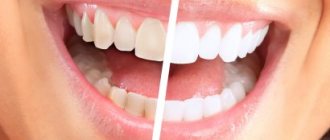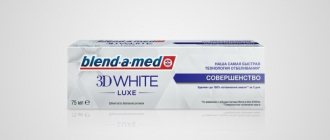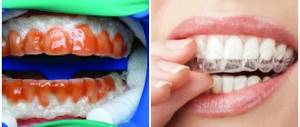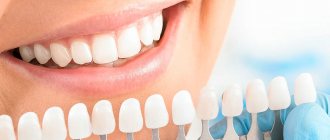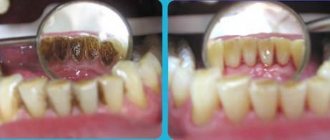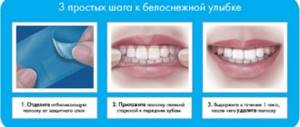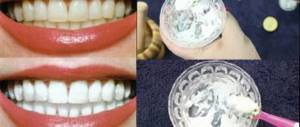What is the difference between whitening and enamel lightening?
The fundamental difference is in the essence of the procedures, but patients sometimes confuse these two concepts.
Whitening involves chemical destruction of pigments in enamel. Powerful oxidizing compounds act on tooth enamel, releasing colored pigments, thereby discoloring grayish or yellowish shades.
Lightening is a mechanical manipulation, sometimes called cleaning. The session involves removing plaque from the surface of the crowns. Small abrasive particles remove a thin film of plaque, while teeth brighten, but not as radically as with whitening.
Thanks to modern innovations, both procedures are relatively safe for the health of teeth and gums, but there are some risks:
- sensitivity may worsen in the first few days after the session. As a rule, it goes away, and after a few days the patient does not feel discomfort;
- Microscopic pores may appear on the enamel, which can subsequently be dynamically filled with pigment from coloring products. Therefore, in the first days after bleaching, it is important to follow a “white diet”;
- An uneven shade of enamel may appear when the crowns have fillings. In this case, whitening will have to be combined with replacing fillings to get an impeccable result;
- outdated procedures had a high risk of burning the gums or oral mucosa. Modern technologies, owned by qualified dentists, can protect patients from all this.
All of the listed nuances can be avoided if the procedures are performed in a truly trusted place. Dentists also recommend remineralizing the enamel layer to strengthen its structure and prevent destruction. The 32 Dent clinic has the best equipment; its staff includes professional dental hygienists who will perform whitening carefully and as atraumatically as possible. A white Hollywood smile is possible without risks!
It is important! Whitening and lightening are performed by a doctor only on healthy teeth. Before the procedures, it is important to treat caries and other diseases. If the gums are weakened, they should be strengthened so that the effect does not have the opposite effect.
What happens to teeth during whitening
Dehydration of tooth tissue is a side effect that occurs during the teeth whitening process. This effect is especially noticeable immediately after the whitening procedure is completed - the teeth look too white .
Dehydration is observed during clinical teeth whitening using light sources that activate the whitening process (special lamps, laser radiation)
Dehydration (dehydration) of dental tissues can be observed for several days after whitening.
As this effect decreases, the color of the whitened teeth returns slightly to its original state. Knowing that teeth become dehydrated during the whitening process, one might wonder if this will cause unwanted consequences.
To understand how a light source can cause dehydration, let's touch on some theory. During the whitening procedure, light emitted by a special lamp or laser penetrates the tooth tissue with high intensity. Part of the whitening gel evaporates from the surface of the teeth. The gel remaining on the teeth actually produces a whitening effect.
1. Whitening gel on the tooth surface
2. Light source
3. Free oxygen released by the gel
The light emitted by the lamp is more intensely absorbed by dark-colored areas of the tooth. Light areas of the tooth, on the contrary, reflect light. The light absorbed by the tooth is converted into thermal energy. Such anatomical components of the tooth as pulp and dentin are the darkest tissues of the tooth. Therefore, they are most exposed to heat, which leads to internal overheating of the tooth.
Hard tooth tissues (tooth enamel, dentin) do not have high thermal conductivity, due to which the liquid contained in the pulp and dentin expands. This leads to the release of fluid from the tooth tissue.
By its structure, the tooth is a porous body, which allows fluid to escape from its tissues. For the same reason, it becomes possible for the components of the whitening gel to penetrate the dental tissues.
Dehydration and overheating of tooth tissue often causes a painful reaction that can persist for several days after teeth whitening. As a rule, the patient is warned about this unpleasant moment of bleaching.
To combat this phenomenon, during the whitening process, teeth are coated with a special composition that reduces the pain reaction. But, unfortunately, some people still experience pain after teeth whitening.
As a rule, saturation of dental tissues with liquid obtained from saliva occurs within 72 hours after the whitening procedure. As the moisture in the dental tissues is restored, their sensitivity also decreases. This does not cause any irreversible effects on teeth.
Beauty requires sacrifice - while this slogan is relevant in relation to teeth whitening. In order to make teeth whitening more comfortable and painless, scientific developments are underway to create whitening systems that are free of unpleasant consequences.
TOP most popular teeth whitening methods
1. Air Flow – so-called mechanical (sandblasting) clarification, when a special device is used to direct a jet of soda microparticles to each crown. The smallest abrasive particles make it possible to eliminate a thin film, destroying layers of plaque. As a result, after Air Flow, teeth brighten by 1 – 2 shades. Before the session, the patient puts on protective glasses, and the lips and gums are covered with a special protective composition. Finally, the doctor coats the client's teeth with a high fluoride gel to strengthen the enamel layer.
Advantages of Air Flow:
- a hygienic procedure that allows you to eliminate plaque, which is a good prevention of caries;
- teeth are cleaned of stone, including in hard-to-reach places (interdental space);
- with Air Flow the risk of caries formation is reduced;
- lightening is completely painless - anesthesia is used extremely rarely;
- the session can be performed for people who wear braces;
- 40 minutes – and you get the feeling of “clean” teeth and a beautiful smile.
2. Ultrasonic clarification is a popular hygienic procedure when ultrasound waves are used instead of the sandblasting nozzle of the device. Due to the vibration effect, plaque is destroyed. For comparison, the effect of ultrasound is much more powerful than even the strongest jet of water and soda. As a result, teeth are brightened by 2 – 3 shades.
Advantages of ultrasonic clarification:
- visible result after - for some patients, ultrasound lightening alone is enough;
- the risk of caries is reduced;
- elimination of unpleasant odor from the oral cavity;
- safety - vibration waves do not affect the deep layers of enamel, although sometimes after all the actions a slight increase in tooth sensitivity may be observed;
- The manipulation can be performed on people with implants and prostheses.
Some 35 - 45 minutes - a beautiful smile and no stone or plaque!
Cosmetic whitening in beauty salons requires a medical license
June 27, 2021 Determination of the Supreme Court of the Russian Federation: for cosmetic teeth whitening using an LED lamp in a beauty salon, a license for medical activities is required!
Teeth whitening services using systems such as the “Mobil LED system” /any “cold” light lamp/ (using an oxidizer /any peroxide gel/, which is activated by the light of an LED lamp) are considered medical, therefore, only the person who received the right to provide them license for the relevant type of medical activity. This was pointed out by the courts in the case challenging the administrative punishment under Part 2 of Art. 14.1 Code of Administrative Offenses (activities without a license). The punishment was expressed in a warning (Decision of the Supreme Court of the Russian Federation dated May 27, 2021 No. 309-ES19-6372). The fact of the offense was revealed during an inspection by the prosecutor - he was studying the activities of a hairdressing salon. In the same establishment, a certain girl was discovered - an individual entrepreneur (individual entrepreneur), who provided teeth whitening services to everyone. Bleaching was carried out using equipment and materials: chairs; LED lamp (LED lamp); mouth guards; brightening gel; activator spray for pre-cleaning/treatment of tooth enamel; safety glasses, bins for consumer waste material and water for rinsing the mouth after cosmetic teeth whitening.
The IP sincerely told the prosecutor that simply using the gel to lighten teeth at home will not lead to a noticeable result, since exposure to the rays of an LED lamp is necessary to activate the oxidative process. This information was subsequently used against the teeth whitener.
The prosecutor of the prosecutor's office of the Turin district of the Sverdlovsk region, and after him the courts, judged as follows:
Medical intervention is a type, including medical manipulation, that has a preventive, therapeutic, rehabilitation focus (Clause 5, Article 2 of the Federal Law of November 21, 2011 No. 323-FZ “On the fundamentals of protecting the health of citizens in the Russian Federation”) .
The concept and list of medical services are defined by their Nomenclature, approved. by order of the Ministry of Health of the Russian Federation of October 13, 2021 No. 804n.
The nomenclature of medical services is a systematic list of codes and names of medical services in healthcare, and this list is divided into 2 classes: “A” and “B”, built on a hierarchical principle. Class “A” section includes medical services that represent certain types of medical interventions that have a complete meaning.
In this case, sections of class “A” designate, inter alia, the following types of services:
14 – care for patients or individual anatomical and physiological elements of the body (oral cavity, upper respiratory tract, etc.); 22 – treatment using radiation (sound, light, ultraviolet, laser) effects; 23 – diagnosis and treatment not indicated in other sections; 24 – diagnosis and treatment based on thermal effects;
At the same time, according to the Nomenclature, the class of section “A” (from 01 to 31) designates the anatomical and functional area, in which “07” is the oral cavity and teeth;
Thus, teeth whitening activities are a medical service, and in accordance with the mentioned Nomenclature, they are coded as A16.07.050 medical class.
And since the teeth whitening service provided by an entrepreneur is medical, it is subject to licensing.
The Supreme Court of the Russian Federation agreed with the proposed qualification of the offense and added that, by providing medical services in the absence of a license, the individual entrepreneur was aware of the illegal nature of her actions, foresaw their consequences and deliberately allowed them or was indifferent to them.
List of the most popular teeth whitening procedures
1. ZOOM is a photo-whitening technique in which the dentist applies a special gel with a high content of hydrogen peroxide (from 25 to 35%) to the surface of the teeth. The composition is activated by a light lamp. As a result, teeth are brightened by 10 or more tones.
Advantages of ZOOM:
- the effect of a snow-white smile lasts for 2 – 3 years;
- your teeth are white, even if after the manipulations you drink coffee, red wine, or smoke;
- lack of sensitivity of dental tissues if high-quality equipment is used.
Like any procedure, ZOOM has a number of nuances. For example, since the effect occurs quickly, this places a certain load on the enamel coating. Therefore, the teeth will need a little more time for the recovery period after “stress” to pass. There are also a number of restrictions for ZOOM: pregnancy, breastfeeding, young age under 16 years.
2. Laser whitening is a laser treatment technique that activates a gel based on hydrogen peroxide. Unlike photobleaching, when a light beam is used, the effect of a laser on the gel is considered faster and more effective. Hence the amazing effect when teeth become 10 - 12 shades lighter in one session!
Advantages of laser whitening:
- powerful antibacterial effect - reduces the risk of dental caries;
- the doctor uses a gel with a small concentration of hydrogen peroxide, which significantly reduces the risk of increasing enamel sensitivity;
- the result lasts for 4 – 5 years.
There is also a certain nuance of laser whitening - it is high cost.
What is a professional teeth whitening system?
There are several types of professional teeth whitening systems. Each type has significant differences, so we advise you to carefully read each of them:
Laser whitening
It is carried out using a whitening gel, which is applied to the teeth and exposed to a laser beam.
The advantage of this procedure is that under the influence of the laser, the tooth surface heats up much less than when using a UV lamp.
The process also takes less time compared to other types of whitening. Laser whitening is also used in cases where the patient wears or has worn braces - in some cases, these structures can leave dark spots on the enamel.
Ultrasonic whitening
One of the most gentle and safe whitening methods, in which ultrasonic vibrations are applied to the tooth surface.
The only disadvantage of this technique is that to achieve maximum effect you must undergo several procedures.
Light whitening
Before the teeth whitening procedure with the ZOOM system, the patient must undergo professional teeth cleaning and only after that can teeth whitening begin.
A special gel containing active substances is applied to the teeth, onto which UV radiation is then directed.
As a result, a chemical reaction occurs, through which the enamel lightens. Professional teeth cleaning and dental whitening can lighten enamel by 4 to 12 shades on the Vita scale.
In addition to the whitening effect, ZOOM gel takes care of teeth due to the presence of calcium phosphate in its composition.
Photo teeth whitening
The AmazingWhite whitening procedure is similar to ZOOM whitening, the only difference being that it can be performed either with or without a UV lamp. The effect of AmazingWhite whitening is to lighten the enamel by 4-6 shades. This is a more budget-friendly option for professional teeth whitening.
Chemical bleaching
Chemical types of teeth whitening include Opalescence XtraBoost enamel lightening. This is a lamp-free whitening method based on the use of gel with fluoride and carbamide peroxide.
It is available in two varieties - for professional teeth whitening in a dental clinic, and for whitening at home. These two types differ in the concentration of active substances.
Endobleaching or intracoronal bleaching
It is carried out after endodontic treatment or tooth trauma. The essence of this whitening method is that the brightening gel is placed directly in the tooth cavity, then a temporary filling is placed.
Once the desired effect is achieved, the tooth is filled with a permanent filling.
The results of professional teeth whitening last on average from two to seven years and depend on the chosen method and on the individual characteristics of the patient.
Types of home whitening
1. Toothpaste with a whitening effect is the easiest way to slightly lighten the enamel, but you should not expect a dramatic effect. Unfortunately, the microscopic abrasive particles in the toothpaste are not able to remove plaque and tartar, as can be done in a doctor’s office.
Features of whitening toothpastes:
- in addition to abrasive microparticles, pastes often contain components that destroy plaque at the protein level;
- The structure of the paste also contains components that soften tartar. After using such compositions, deposits are easier to remove in dentistry.
Note!
It is not recommended to use whitening pastes and gels every day - optimally once or twice in seven days. Frequent use of such pastes can lead to the opposite effect, since pigments from coffee, black tea, etc. can penetrate into the gaps formed. If you want to choose a whitening paste for every day, give preference to compositions with an abrasiveness index of “75”. 2. Ready-made whitening kits - they include strips, silicone trays with gel, pencils, etc. In terms of their effectiveness, these methods are not as effective as professional procedures. The effect of whitening with a gel and silicone tray is only 1 or 2 tones, the result of whitening with a marker or strips is up to 3 tones, respectively.
Features of whitening kits:
- the result is cumulative - it will not be possible to whiten the enamel in one or even two sessions. On average, the course lasts several weeks and even months;
- if a person has abundant stone deposits, there will be no effect from a home session;
- If you constantly wear silicone aligners with gel or strips, there is a high risk of gum irritation. Also, gum burns are possible if the safety rules for home whitening are not followed - not all people follow the instructions.
Folk remedies for whitening
Despite the dynamic development of cosmetic dentistry, some people still resort to traditional whitening remedies:
- lightening with soda, when the brush is dipped in a solution of baking soda, and the person brushes his teeth with this composition;
- home whitening with activated carbon. First, activated carbon tablets are crushed and the teeth are brushed with the resulting powder. After brushing, it is important to rinse your mouth thoroughly to remove any excess.
It is important!
Under no circumstances should you mix baking soda with hydrogen peroxide and brush your teeth with this solution. There is a high risk of burns to the gums and mucous membranes, after which it will be extremely difficult for a person to recover. Using folk remedies, of course, is not prohibited, but there are a lot of ready-made solutions that are specifically designed for home whitening. When choosing a method, be sure to consult with a dentist who will offer an inexpensive but effective option for home lightening.
Is cosmetic teeth whitening harmful?
An alternative to professional enamel whitening is cosmetic, which is usually done at home, and all equipment for cosmetic teeth whitening can be purchased at a pharmacy. Lightening gels and special mouth guards are used for the procedure.
A feature of this technique is the use of whitening preparations with less active components - in professional lightening, the content of the lightening agent is almost 40%, while in cosmetic whitening agents the proportion of active substances does not exceed 10-12%.
Specialists at Eurodent clinics often have to face the question: “Is cosmetic teeth whitening harmful?” Our answer is no, it is not harmful, but the procedure requires a preliminary examination and consultation with a dentist, because has a number of limitations.
Contraindications to cosmetic teeth whitening:
- Untreated dental diseases – caries, pulpitis, etc.;
- Availability of braces, crowns and other orthodontic structures;
- Ceramic inlays and photopolymer fillings;
- Diseases of the gums and oral mucosa;
- Thinning of tooth enamel - congenital or acquired;
- Enamel hypersensitivity;
- Systemic diseases - diabetes, oncology, tuberculosis, etc.;
- Viral diseases;
- Pregnancy and lactation period.
All of the above nuances are also contraindications for professional teeth whitening. As an undesirable factor for the lightening procedure, the patient’s addiction to smoking and drinking drinks containing dyes (coffee, juices, etc.) should be taken into account.
In this case, the lightening effect will last a maximum of a month.
You can get more detailed information about the whitening procedure and undergo an initial examination at the Eurodent clinic at any time convenient for you - we work around the clock.
Based on: 3 votes
Which method is better? We study patient reviews and doctor recommendations
We took into account the expert opinion of dentists and reviews of real patients, on the basis of which we made objective conclusions:
- Air Flow brushing carries risks for people with inflammatory gum disease. If a person has weak gums and is susceptible to periodontal disease, bleeding and severe discomfort may occur after brushing. An experienced doctor will never perform mechanical cleaning until he is sure of the optimal condition of the gums. Bleeding microdamages can cause infection, as a result of which a seemingly harmless cleaning will turn into a serious problem with consequences.
- After ZOOM photo whitening, many patients with healthy teeth experience severe pain. It goes away after a few hours, but the person experiences this time with great discomfort. To reduce pain, many people resort to painkillers. In fact, to slightly relieve pain, you can lubricate your gums with lidocaine-based creams. Local anesthesia is not as harmful as handfuls of analgesics taken orally.
- People who wear fixed dentures need to be especially careful when choosing a cleaning technique. For example, ultrasonic techniques are not compatible with nylon structures. Vibration waves have a negative effect on the polymer - the prosthesis will have to be changed after the enamel is lightened, which entails additional costs.
- The laser technique is sometimes performed in two stages. For example, when a patient initially has yellow enamel, but wants radical whiteness. In such cases, the break between two sessions can be 10 days, and during this period a strict “white” diet is recommended, no solid foods (solid foods can damage weakened enamel).
Note! The effectiveness of whitening complexes largely depends not only on the qualifications of the doctor and the chosen technique, but also on the patient’s compliance with the rules after the manipulations.
